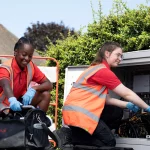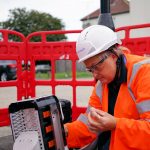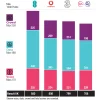Broadband ISP EE UK Adds Stream Mode to WiFi Enhancer Service

Mobile and broadband ISP EE (BT) has today added the new ‘Stream Mode’ feature to their existing WiFi Enhancer service, which works by claiming to “intelligently prioritise a customer’s favourite streaming apps, helping customers enjoy smooth, high-quality streaming … even when the entire household is online.”
Just to recap. The Wi-Fi Enhancer service is an app-controlled feature that enables you to prioritise traffic to your connection (e.g. you can currently choose for it to prioritise traffic for gaming or work), which can be handy in larger households with multiple users and devices. This is included as standard with EE’s “Made for Gamers” and “Busiest Home” FTTP broadband bundles, or as a £5 per month 30-day rolling add-on on other packages. A Smart Hub Plus or Smart Hub Pro router is also required.
By comparison, the new ‘Stream Mode‘ feature is designed to expand upon this idea by prioritising traffic from “leading streaming apps” (e.g. Amazon Prime Video, TNT Sports on discovery+ etc.), which EE said should “minimise buffering and improve viewing quality throughout the home“.
Advertisement
In addition, for creators and gamers, EE states that Stream Mode should also help with uploads to platforms like Twitch and YouTube, “making live streaming and content sharing faster and more reliable“. But we could really do with seeing some more technical details on precisely how it’s achieving this.
Luciano Oliveira, EE’s Director of Product, Home & TV, said:
“With Stream Mode, we’re giving customers even more control over their broadband experience. Whether its binge-watching boxsets or watching live sport, Stream Mode puts streaming apps in the fast lane, so customers can enjoy uninterrupted entertainment, even when the whole household is online. It’s all part of our mission to create a smarter, more personalised, WiFi experience, and it’s only available on EE.”
In theory this sounds like a good feature, although strictly speaking it shouldn’t really be necessary on a modern and ultrafast or gigabit speed Fibre-to-the-Premises (FTTP) broadband connection, provided the ISP is doing their job to provide every customer with a good quality connection and establishing strong peering/routing arrangements.
The fact that you can activate this for the “whole household” also makes it sound like EE’s default connection is inferior. The approach makes us wonder exactly what sort of tweaks the provider is actually applying in order to prioritise traffic and why other customers are not able to benefit from this by default (there’s a net neutrality argument).
On the other hand, this is a hard thing to benchmark, and we’ve not seen any solid independent studies to show that Stream Mode will actually make a tangible difference, at least not a difference that you couldn’t achieve by simply taking a faster broadband speed (or even by switching ISP to one that doesn’t require this for you to get the best connection).
Advertisement
In any case, Stream Mode is being launched via a “phased roll out” to eligible EE home broadband customers in the “coming weeks“, assuming you’re making use of WiFi Enhancer of course.
Mark is a professional technology writer, IT consultant and computer engineer from Dorset (England), he also founded ISPreview in 1999 and enjoys analysing the latest telecoms and broadband developments. Find me on X (Twitter), Mastodon, Facebook, BlueSky, Threads.net and Linkedin.
« Broadband ISP TalkTalk UK Adopt NiCE’s AI-Powered Customer Service Platform























































This is a solution for congestion on the wireless interface of the customer’s endpoint, rather than the quality of the uplink to the ISP.
Sounds like an advanced form of QoS, presumably looking at the actual destination IP to work out whether it’s Netflix etc. or just a regular download. I can see it certainly helping on an FTTC connection where there can be enough contention for bandwidth that devices with limited buffering (eg. TVs) quickly run out of data if someone else is downloading a game or something.
It sounds like a “dumbed down” QoS where the hub takes all the guess work out of bandwidth allocation for the end user by providing a simple toggle switch. As Mark rightly points out, unless you’re in a very busy household with lots of WiFi congestion, or have a low bandwidth connection, it’s not bound to make much difference and is more of a marketing tool for EE in my opinion.
Working in tech support in the days of low speed FTTC or even ADSL could be frustrating when a customer would complain of slow upload speeds when trying to back up their entire phone to icloud whilst simultaneously trying to download things to their new phone and stream Netflix at the same time was not fun.